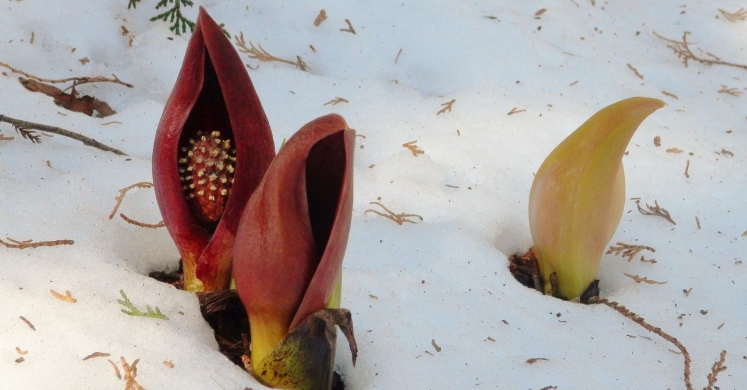Blog

#bioPGH Blog: Skunk Cabbages: Our Stinky Little Signs of Spring
 A resource of Biophilia: Pittsburgh, #bioPGH is a weekly blog and social media series that aims to encourage both children and adults to reconnect with nature and enjoy what each of our distinctive seasons has to offer.
A resource of Biophilia: Pittsburgh, #bioPGH is a weekly blog and social media series that aims to encourage both children and adults to reconnect with nature and enjoy what each of our distinctive seasons has to offer.
You have probably seen (or perhaps smelled!) the skunk cabbage — a unique early bloom before spring has begun, with its distinctive cone shape peeking out from muddy snow-covered ground. This hardy plant rises from a landscape still clinging to winter, yet any snow immediately around the skunk cabbage’s base is melted. Have you ever wondered about this curious little plant, which triumphantly sprouts through cold weather and announces its presence with so distinct an odor? Let’s learn more about it!
You are most likely to spy a skunk cabbage near a wetland or in a low, soggy area. Though it can only handle standing water for a limited amount of time, the skunk cabbage needs damp soil for optimal growth. When you do spot one, the most visible parts of a skunk cabbage are the spathe and the spadix. The spathe is the large hood-like sheath that makes up the bulk of the aboveground part of a skunk cabbage. It usually is a mottled purple-green-yellow color and looks like a thick, curved leaf wrapping around a center point. The spadix, on the other hand, is the structure inside the spathe, and it is actually a stalk of teeny-tiny flowers.
These tiny flowers don’t quite smell like roses, though. Skunk cabbages are most appropriately known for their distinct smell of rotting carrion! This blunt stink, especially if you accidentally step on one, serves the important role of attracting pollinators. For pollination purposes, though, skunk cabbages rely on flies and insects who would normally dine on carrion, and to attract something that likes the smell of dead meat, well…one must smell like dead meat.
As if that weren’t intriguing enough, these plants are what is called “thermogenic” — they generate their own heat! If you’ve seen skunk cabbages in early spring, when there is still some light snow on the ground, you might have noticed that the space directly around the base of the skunk cabbage is snow-free. That is because skunk cabbages can raise their own internal temperatures up to 70 degrees Fahrenheit above ambient temperature! The spadix warms up by quickly metabolizing starches that were stored in the roots over winter, and the burned up energy radiates as heat. They may not have gotten to show off their amazing feat this winter, but rest assured, they can be warm plants.
Keep your eyes out for our stinky little sign of spring! They should be popping up all around us by now.
Connecting to the Outdoors Tip: If you’d like to find skunk cabbages, check out trails near wetlands. Skunk cabbages need plenty of water in the soil and prefer wetter ground. Teachers, with a bit of planning and the right equipment, you can try a variation of this lab project developed at the Central Connecticut State University.
Continue the Conversation: Share your nature discoveries with our community by posting to Twitter and Instagram with hashtag #bioPGH, and R.S.V.P. to attend our next Biophilia: Pittsburgh meeting.
Resources
Nature Conservancy: Journey with Nature – Skunk Cabbage
Penn State University: Ecologist’s Notebook Blog
National Wildlife Federation: Skunk Cabbage
Ito et al 2004: Temperature-Triggered Periodical Thermogenic Oscillations in Skunk Cabbage (Symplocarpus foetidus)
Photo Credit: Sakaori CC-BY-SA-3.0 and Pexel CC0

